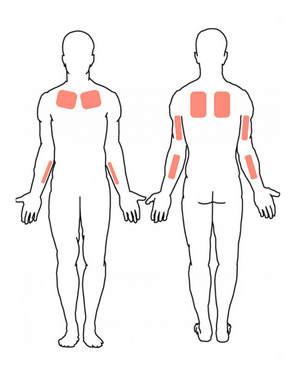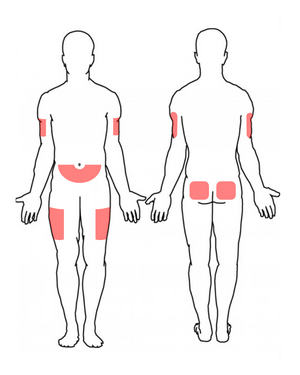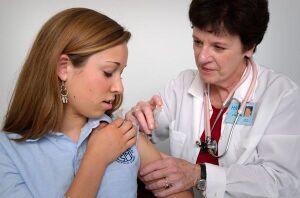Injection application
Definition: Injection is the introduction of a drug into the body by the parenteral route.
Tools[edit | edit source]
Syringes, injection needles, ampoules or vials, disinfectant, pulp squares, emission tray, patch, patient documentation, sterile gloves, plastic container for used needles.
The injection needle must be sharp, sterile, passable and smooth. The needle consists of a plastic cone and a metal body, the tip of which is ground. The needle bodies have different lengths and clearances, which are given in Gaug units. The tips of the needles have different lengths of sharpening, which depends on their sharpness. It is true that the longer the sharpening, the sharper the needle.
A syringe is a single-use plastic device. It consists of a calibrated cylinder, a movable piston and a cone. The sterility of the cone must be maintained as this is where the cone of the injection needle is attached.
The medicines' are sold in glass ampoules and have been manufactured under sterile conditions. The ampoule has a filed neck that can be broken off.
Injection preparation[edit | edit source]
- We take care of our own safety, which is why we prepare the medicine away from the eyes. In some cases, it is necessary to work in sterile gloves and be careful when handling sharp objects.
- We take the ampoule with the medicine and gently tap it to make sure that all the medicine is in the body of the ampoule and not in its neck.
- Disinfect the neck with disinfectant sprayed on a square of cotton wool.
- We break off the head in the marked place by pressing on the neck. We are careful that no glass gets into the ampoule. In the event that this happens, we must throw away the ampoule and use a new one.
- Remove the syringe from the plastic packaging and be careful not to touch the cone.
- Connect the cone of the syringe to the cone of the needle.
- Suck the contents of the ampoule.
- If the medicine is in powder form, it must be diluted first. physiological solution is usually used for this.
- Check expiration, including saline, before preparation.
The most common types of injection application[edit | edit source]
Intradermal (i.d.)[edit | edit source]
Suitable places: shoulder skin, outer and inner forearms, outer thighs, back or abdomen.
Uses: tuberculin test, allergen tests, BCG vaccine[1], local anesthesia.
- Disinfect the injection site and let the antiseptic dry.
- The needle is inserted at an angle of 15°, i.e. almost horizontally with the skin.
- Only a small amount of medicine (0.1 ml) can be applied in this way.
- A harder pimple will appear at the application site.
- Do not massage the injection site so as not to push out the substance.
Subcutaneous (s.c.)[edit | edit source]
Suitable places: outer side of arm and thigh, subcutaneous abdomen, ventrogluteal and dorsogluteal area.
Usage: low molecular weight heparin, insulin (medium duration of action, long duration of action) [2].
- Disinfect the injection site and let the antiseptic dry.
- We will create a skin fold.
- Insert the needle at an angle of 45°, air bubbles must not enter the syringe.
- We will allow the skin fold.
- We aspire.
- If no blood appears, we can apply the medicine by applying pressure on the plunger. If blood appears, it means that we have punctured a vessel. It is therefore necessary to pull out the needle and repeat the procedure in another place.
- Cover the injection site and press with a square of cotton wool.
- 2 ml of medicine can be applied in this way. Depending on the amount, it is possible that a palpable lump appears in the subcutaneous tissue.
Exception: When applying anticoagulants (e.g. Clexane, Fraxiparine) we perform an injection at a 90° angle in the abdomen. We do not aspirate and hold the skin fold throughout the application. We do not massage the injection site after the application.
Intramuscular (i.m.)[edit | edit source]
Suitable places: m. glutaeus maximus, m. glutaeus medius, m. vastus lateralis, m. deltoideus.
Usage: insulin (short duration of action)[2], antibiotic treatment (penicillin, streptomycin).
- We feel the injection site and then disinfect it.
- Turn off the skin.
- We introduce the injection at an angle of 90° (with the exception of the glutaeus medius muscle, where we introduce it at an angle of 60°).
- We aspire.
- We apply the medicine.
- After pulling out the needle, cover the injection site with a patch.
Warning: Due to the risk of impaling the bone, we perform an injection of a skin flap in children and patients with a small amount of muscle mass. At the same time, we perform an injection at an angle of 60°. For newborns, we choose the vastus lateralis muscle as the injection site, and for children under two years of age, usually the glutaeus medius muscle. For older children, we most often choose, as well as for adults, the glutaeus maximus m.
Intravenous (i.v.)[edit | edit source]
Suitable places: soft straight veins (most often on the upper limbs).
Usage:antibiotics, transfusion, infusion, parenteral nutrition[1].
- Put Esmarch's tourniquet over the injection site.
- We invite the patient to exercise the hand.
- We feel a suitable vein.
- Disinfect the skin.
- Remove air bubbles from the syringe.
- Prick the vein at a 45° angle.
- We aspirate to check that the needle is in the vein.
- We loosen the strap and inject the medicine.
- After application, press the area with a tampon.
- If a large amount is administered, a peripheral venous catheter is inserted and the drug is given by infusion.
Side effects after administration[edit | edit source]
- Expected (eg, antihypertensive drugs may cause fainting, nausea);
- Unexpected (eg allergy to PNC);
- Toxic (e.g. due to overdose, poor excretion);
- Allergic (allergic reaction to the drug, the most serious is anaphylactic shock);
- Drug tolerance (a low or decreasing physiological response to a drug that leads to the need to increase the dose of the drug to achieve the desired effect);
- Drug interaction (mutual action in the body during simultaneous administration of two drugs, when the effects of one or both of them change).
Possible Complications[edit | edit source]
- Vessel puncture: We check with aspiration, the vessel has been punctured if blood appears in the syringe. If this happens, we need to pull out the needle and throw it away. We then repeat the procedure in another place.
- bonei impalement: This complication can occur in people with weak subcutaneous and muscle layers. The end of the needle may create a bend on impact with the bone, causing pain when the needle is withdrawn. We prevent this complication by carefully choosing the injection site.
- Pricking of a nerve (the patient complains of tingling or pain shooting into the limb).
- Infection: We must prevent infection by following an aseptic work procedure.
- Abscess (occurs if the drug is not injected directly into the muscle, manifested by redness, pain, stiffness at the injection site).
Links[edit | edit source]
Related Articles[edit | edit source]
References[edit | edit source]
- KOLEKTIV AUTORŮ,. Základy ošetřování nemocných. 1. edition. Karolinum, 2005. 145 pp. ISBN 80-246-0845-6.
- MIKŠOVÁ, Zdeňka. Kapitoly z ošetřovatelské péče I.. 2. edition. Praha : Grada, 2006. 248 pp. ISBN 80-247-1442-6.
- MIKŠOVÁ, Zdeňka. Kapitoly z ošetřovatelské péče II.. 2. edition. Praha : Grada, 2006. 171 pp. ISBN 80-247-1443-4.
- RICHARDS, A – EDWARDS, S. Repetitorium pro zdravotní sestry. 1. edition. Praha : Grada, 2004. 376 pp. ISBN 80-247-0932-5.
- ROZSYPALOVÁ, M – ŠAFRÁNKOVÁ, A. Ošetřovatelství I., II.. 1. edition. Informatorium, 2002. 239 pp. ISBN 80-86073-97-1.
- WORKMAN, B – BENNETT, C., L.. Klíčové dovednosti sester. 1. edition. Grada, 2006. 259 pp. ISBN 80-247-1714-X.
- ŠAMÁNKOVÁ, Marie. Základy ošetřovatelství. 1. edition. Karolinum, 2006. 353 pp. ISBN 80-246-1091-4.
- JIRKOVSKÝ, Daniel – HLAVÁČOVÁ, Marie. Ošetřovatelské postupy a intervence [online] . 1. edition. Fakultní nemocnice v Motole, 2012. 411 pp. Available from <https://www.lf2.cuni.cz/files/page/files/2016/inouceb.pdf>. ISBN 978-80-87347-13-3.
External links[edit | edit source]
- OSACKÁ, Petronela. Aplikácia injekcií [online]. Multimediálna podpora výučby klinických a zdravotníckych disciplín :: Portál Jesseniovej lekárskej fakulty Univerzity Komenského, ©4.2.2011. [cit. 2011-12-23]. <https://portal.jfmed.uniba.sk/clanky.php?aid=131>.
Reference[edit | edit source]
- ↑ a b JIRKOVSKÝ, Daniel – HLAVÁČOVÁ, Marie. Ošetřovatelské postupy a intervence : učebnice pro bakalářské a magisterské studium. 1. edition. Fakultní nemocnice v Motole, 2012. 411 pp. pp. 277–288. ISBN 978-80-87347-13-3.
- ↑ a b MLČOCH, Zbyněk. Subkutánní injekce, intradermální injekce - postup aplikace kožní a podkožní injekce [online]. The last revision 2009-11-12, [cit. 2017-01-08]. <http://www.zbynekmlcoch.cz/informace/medicina/osetrovatelstvi-postupy/subkutanni-injekce-intradermalni-injekce-postup-aplikace-kozni-a-podkozni-injekce>.




